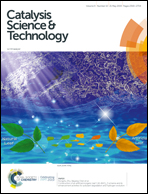Tailoring the morphology of Ni–Pt nanocatalysts through the variation of oleylamine and oleic acid: a study on oxygen reduction from synthesis to fuel cell application†
Abstract
Recent research has focused on the control of the geometric shape of nanoparticles (NPs) to improve their catalytic activity for the oxygen reduction reaction (ORR) in PEM fuel cells. This work studies the effect of the Oam : Oac ratio on the size, morphology, and catalytic activity of several carbon-supported Ni–Pt nanomaterials. Electrochemical tests using ring-disk electrode techniques were used to evaluate the catalytic activity and peroxide formation toward the ORR in acid media. STEM, SEM, EDS, and XRD were performed to study the physical properties of the nanocatalysts synthesized. UV-vis and FTIR spectroscopy were used to characterize the metal–ligand complexes formed during the synthesis. Additionally, accelerated electrochemical degradation testing was undertaken to evaluate the stability of the catalysts. The best nanomaterial in terms of high catalytic activity and stability was chosen and applied as the cathode for fuel cell evaluations. Experimental results revealed that the exclusive use of Oam during the synthesis resulted in polyhedral nanoparticles with the best catalytic activity toward the ORR. On the other hand, an increase in Oac content caused a decrease in Ni content through the formation of a Ni2+:carboxylate complex which promotes nanoparticles smaller in size, variations in their morphology, and a decrease in their catalytic activity.

- This article is part of the themed collection: 2019 Catalysis Science & Technology HOT Articles


 Please wait while we load your content...
Please wait while we load your content...